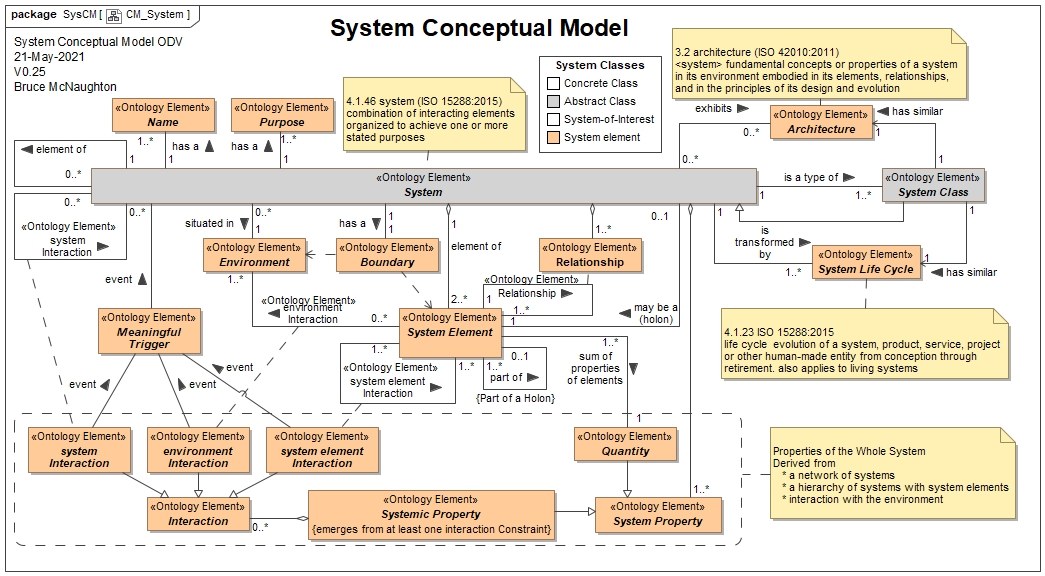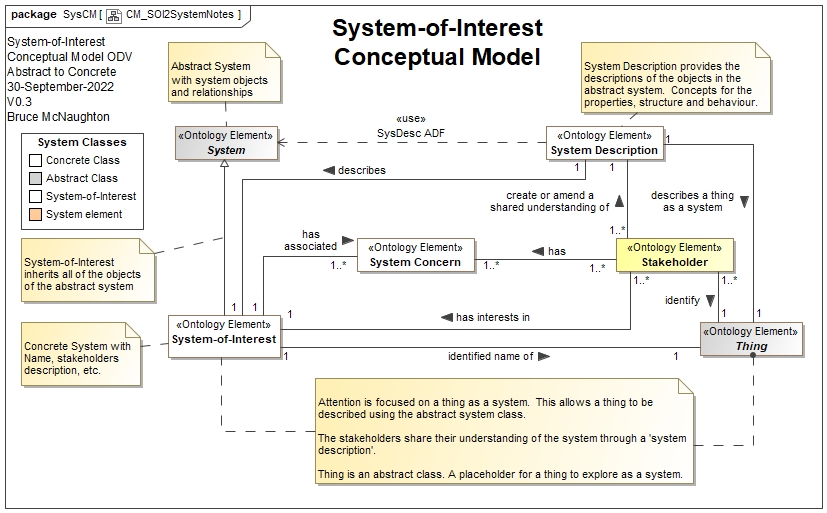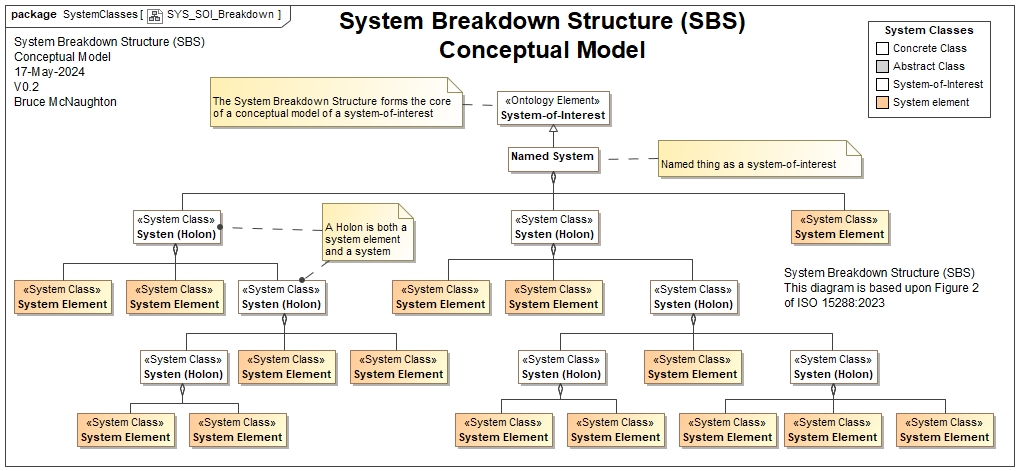View: System Structure (Pattern of Organization)
The system structure or pattern of organization represents a logical model of the system-of-interest. This logical model is independent of any specific concrete realization of any of the systems. This logical model may also be called a conceptual model of the system-of-interest. These concepts establish the terminology used throughout the resulting system description. This conceptual model is closely associated with the identity of the system-of-interest. Changing the conceptual model may actually create a new type of system-of-interest resulting in a new name or capability (e.g. a new type of system-of-interest). This is very similar to the identification of species and the evolution of species.
Concept: Identification and Relationships

The General System Model for an Abstract System has been created as a Category using Category Theory. The model shows a "System of System Concepts" and has three distinct areas:
The Definition of the "System" Category.
The Environment and Context for a system-of-interest
The system concepts describing a system.
Note: The sets identified for the Category: System are identified in this description.
The Definition of the "System" Category
System Category: The Name of the Category
Ob(Systems): The set of all systems related to the System-of-Interest for the model contained in the environment and within the system-of-interest (e.g. system elements as systems)
Hom-Set(a,b): The set of morphisms of two types: System Relationships and System Interactions
Environment and Context Logic statements
System-of-Interest
A System-of-Interest is selected.
A System-of-interest is situated in an Environment or Context.
A System-of-Interest has a Boundary separating the inside from the outside as agreed by stakeholders.
The system-of-Interest establishes the boundary with the other systems in the Environment (Context)
A system-of-interest has a set of Systems that are inside the system-of-interest boundaries Set: SysSOI
The system-of-interest exhibits an architecture.
The system-of-interest is a type of System Class
A System-of-Interest is a representative member of a System Class
Environment and Context
The Environment (Context) for the System-of-Interest is identified.
The Environment (Context) is considered a "Containing System" with Systems in the Set: SysEnv.
A system-of-interest may have multiple environments and will be a member of each environment.
The Environment (Context) contains one or more systems including the System-of-Interest contained in the Set: SysEnv.
The systems in the environment have one or more system relationships with other systems in the environment (logical model) contained in the Set: Hom-Set(SysRel).
The systems in the environment have interactions that contribute to the behavior of the system-of-interest contained in the Set: Hom-Set(SysInt)..
System and System Concepts Logic statements
System Name and Class:
A System has one or more names
A System is a type of one or more System Classes as defined by the System-of-Interest.
System Classes are identified and part of the System Classification Category (Separate Definition).
System Purpose:
A System has one or more purposes.
may be supported by principles, objectives, goals.
System Properties:
A System has one or more system properties. (e.g. a set of system properties).
A systemic property is a type of system property.
Systemic Properties are properties of the whole system not found in any of the parts and emerge through interactions.
A quantity system property is a type of system property.
The quantity system property may be the sum of the property found in one or more systems with the required property.
System Structure (Pattern of Organization):
A System-of-interest contains two or more systems within the boundary fo the System-of-interest.
A System within the SOI has one or more relationships with another System or itself contained in the Set: Hom-Set(SysRel).
A System may be part of a System creating a hierarchy of Systems within a System-of-Interest.
A system that does not have any containing systems is not broken down any further in the system breakdown structure (SBS). These may be known as Leaf Systems.
Behavior (Structural Changes):
A System responds to external or internal triggers or events through interactions.
One or more interactions are needed to generate a systemic property.
Interactions can be from:
a system interacting with another system within the environment (SysEnv) contained in the Set: Hom-Set(SysInt)
a system interacting with one or more systems (a network) within the SOI (SysSOI) contained in the Set: Hom-Set(SysInt).
To characterise the behaviour of a system, an interaction can be described as a process:
Cyclical / repeating Process (an operational type of process)
Developmental process (a life cycle change process)
A System is transformed by one or more life cycles (a development process)..
NOTE: Russell Ackoff has a definition of System that shows how additional constraints and attributes can be added to this list of statements. Russell Ackoff also created a "system" of system concepts. The Abstract System conceptual model can also be viewed as an "Abstract System of System Concepts".
Definition of System based upon the System Conceptual Model:
Abstract System: A system consists of a set of 3 or more systems that interact with systems in the Environment and systems within the System-of-interest to create one or more system properties.
The boundary is a key concept of a system as the boundary provides a way to determine what is inside or outside of the system. The boundary is established through the relationship of the system-of-interest and the other identified systems in the environment (Context). This concept is different from a physical boundary that becomes a system element of a system.
The following system-of-interest conceptual model allows any-thing to be identified as a system-of-interest. The System-of-Interest inherits the full definition of an abstract system to enable the system-of-interest apply the definition to the identified thing.

The System-of-Interest model is described below:
-
The System-of-Interest
-
is a type of Abstract System. This allows the System-of-Interest to inherit all of the abstract system concepts.
-
has an identified name of a Thing
-
is a type of System Class representative of a Thing
-
has associated system concerns
-
-
A set of stakeholders:
-
has interests in a system-of-interest.
-
has concerns about the system-of-interest
-
gain a shared understanding of the system-of-interest by using a System Description.
-
-
The System Description:
-
is created using a System Description ADF
-
describes a system-of-interest using the abstract system definition
-
describes a named thing as a system.
-
Once a set of stakeholders can be identified that have concerns or interests in the system-of-interest, these stakeholders make the system-of-interest a concrete system by identifying the thing by name that can be described in a System Description as a system. The System-of-Interest is a type of System and inherits all of the properties of the system class.
Once a named system-of-interest has been identified, the system-of-interest is then shown using a System Breakdown Structure conceptual model. The following diagram is an example system breakdown structure (using ISO 15288:2023 figure 2) and the repeating system pattern (using ISO 15288:2023 Figure 1).

Each system element that is a holon (both system element and a system) in the system breakdown structure can be selected as a system-of-interest in their own right. Each of the holons inherit the definition of a system. The architecting process is then recursive with a new System-of-Interest. The System Breakdown Structure contains the hierarchical relationships of system elements and holons and may also identify the relationships between the various system elements and holons.
System Patterns
System patterns extend the abstract system model that is suitable for systems in general with patterns that may be useful for specific types of systems. For example, the concept of feedback and control is included in the control system pattern. The adaptive control system pattern builds on the control system pattern with a model based adaptive mechanism.
Only selected parts of the Structure for the system patterns have been included here.
The following PDF contains all of the System Descriptions for the System Patterns.
Link to the System Patterns PDF